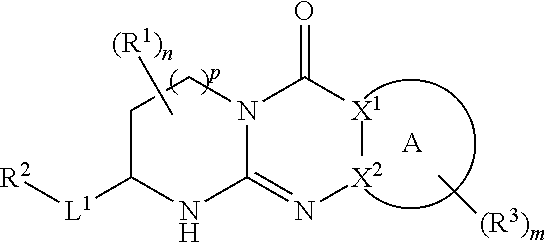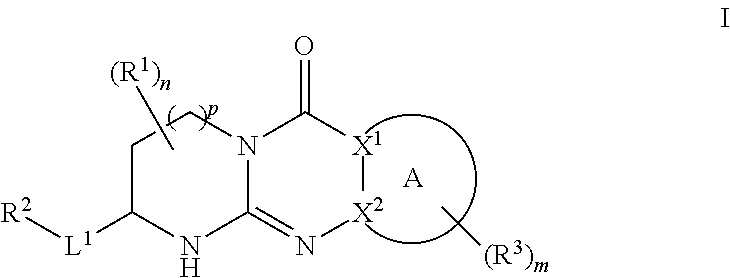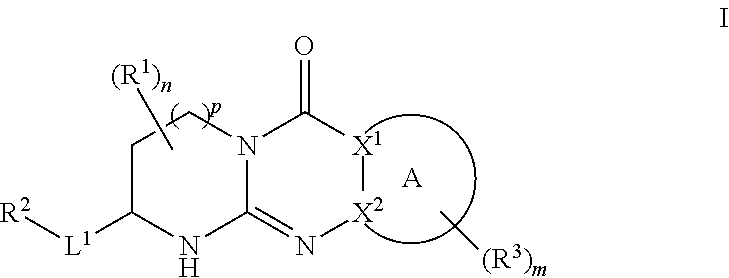Tricyclic guanidine derivative
a technology of tricyclic guanidine and derivative, applied in the direction of heterocyclic compound active ingredients, chemical treatment enzyme inactivation, biocide, etc., can solve the problems of lack of efficacy, burden, and lack of cognitive deficit treatment for schizophrenia
- Summary
- Abstract
- Description
- Claims
- Application Information
AI Technical Summary
Benefits of technology
Problems solved by technology
Method used
Image
Examples
reference example 1
6-Chloro-1-isopropyl-1,5-dihydro-4H-pyrazolo[3,4-d]pyrimidin-4-one
[0187]
[0188]To a solution of 4,6-dichloro-1-isopropyl-1H-pyrazolo[3,4-d]pyrimidine (6.14 g, 26.57 mmol) in THF (80 mL) was added 2M sodium hydroxide (240 mL, 159.42 mmol) and the mixture was stirred at 50° C. for 12.5 h. After concentration under reduce pressure, the residue was added 5 M hydrochloric acid (26 mL) and filtrated to give title compound (5.53 g, 98%) as white solids. 1H NMR (400 MHz, CDCl3): δ 10.82 (br s, 1H), 8.10 (s, 1H), 5.01 (sept, J=6.6 Hz, 1H), 1.54 (d, J=6.6 Hz, 6H). LCMS: m / z=213 [M+H]+.
4,6-Dichloro-1-isopropyl-1H-pyrazolo[3,4-d]pyrimidine
[0189]To a solution of 7,4,6-trichloro-5-pyrimidinecarboxaldehyde (6.00 g, 28.38 mmol) in EtOH (120 mL) was cooled to −78° C. and added isopropylhydrazine hydrochloric (3.14 g, 28.38 mmol) under a N2 atmosphere. To a solution was added DIPEA (14.83 mL, 85.14 mmol) dropwise. The mixture was stirred at −78° C. for 2 h and then warmed up to rt and stirred at this ...
reference example 2
2-Chloro-7-(tetrahydro-2H-pyran-4-yl)imidazo[5,1-f][1,2,4]triazin-4(1H)-one
[0190]
[0191]To the solution of 2,4-dichloro-7-(tetrahydro-2H-pyran-4-yl)imidazo[5,1-f][1,2,4]triazine (1.2 g) in tetrahydrofuran (20 mL) was added 2M potassium hydroxide aq. solution (20 mL). The mixture was stirred for 2 h at 50° C., and then was neutralized with 1M hydrochloric acid. The mixture was filtered to get the titled compound (0.78 g, 70%). 1H NMR (400 MHz, DMSO-d6) δ 1.79-1.88 (m, 4H), 3.34-3.38 (m, 1H), 3.46-3.53 (m, 2H), 3.91-3.95 (m, 2H), 7.76 (s, 1H), 13.01 (br s, 1H). LCMS: m / z=255 [M+H]+.
2-(Tetrahydro-2H-pyran-4-yl)-4-(trifluoromethyl)-1H-imidazole
[0192]A mixture of sodium acetate trihydrate (27.2 g, 200 mmol) and 3,3-dibromo-1,1,1-trifluoroacetone (26.98 g, 100 mmol) in water (75 ml) was heated under reflux for 1 h. The mixture was then cooled to rt and was slowly added to a solution of tetrahydro-2H-pyran-4-carbaldehyde (90 mmol, 10.27 g) and concentrated ammonium hydroxide solution (50 mL...
reference example 3
4-Amino-5-(tetrahydro-2H-pyran-4-yl)nicotinic acid
[0199]
[0200]A solution of methyl 4-amino-5-(tetrahydro-2H-pyran-4-yl)nicotinate (650 mg, 2.75 mmol) and lithium hydroxide monohydrate (578 mg, 13.8 mmol) in THF (I mL) and H2O (1 L) was stirred at 10° C. for 16 h. The solvent was removed under reduced pressure. The residue was acidified to pH=5-6 with 1M hydrochloric acid. The aqueous was concentrated to dryness. The residue was triturated with water (1 mL) to give the titled compound (590 mg, 97%) as white solids. 1H NMR (400 MHz, DMSO-d6): δ 9.17-8.85 (m, 2H), 8.67 (s, 1H), 8.11 (s, 1H), 7.63-7.55 (m, 1H), 3.97-3.93 (m, 2H), 3.46-3.41 (m, 1H), 3.15-3.10 (m, 2H), 1.74-1.58 (m, 4H).
4-Amino-5-bromonicotinic acid
[0201]A mixture of 4-aminonicotinic acid (20.0 g, 145 mmol) in acetic acid (150 mL) and water (150 mL) was heated to 70° C. and stirred for 1 h. After cooled to 50° C., bromine (25 mL) was added dropwise. Then the mixture was stirred at 50° C. for 16 h. The mixture was cooled t...
PUM
 Login to View More
Login to View More Abstract
Description
Claims
Application Information
 Login to View More
Login to View More - R&D
- Intellectual Property
- Life Sciences
- Materials
- Tech Scout
- Unparalleled Data Quality
- Higher Quality Content
- 60% Fewer Hallucinations
Browse by: Latest US Patents, China's latest patents, Technical Efficacy Thesaurus, Application Domain, Technology Topic, Popular Technical Reports.
© 2025 PatSnap. All rights reserved.Legal|Privacy policy|Modern Slavery Act Transparency Statement|Sitemap|About US| Contact US: help@patsnap.com



